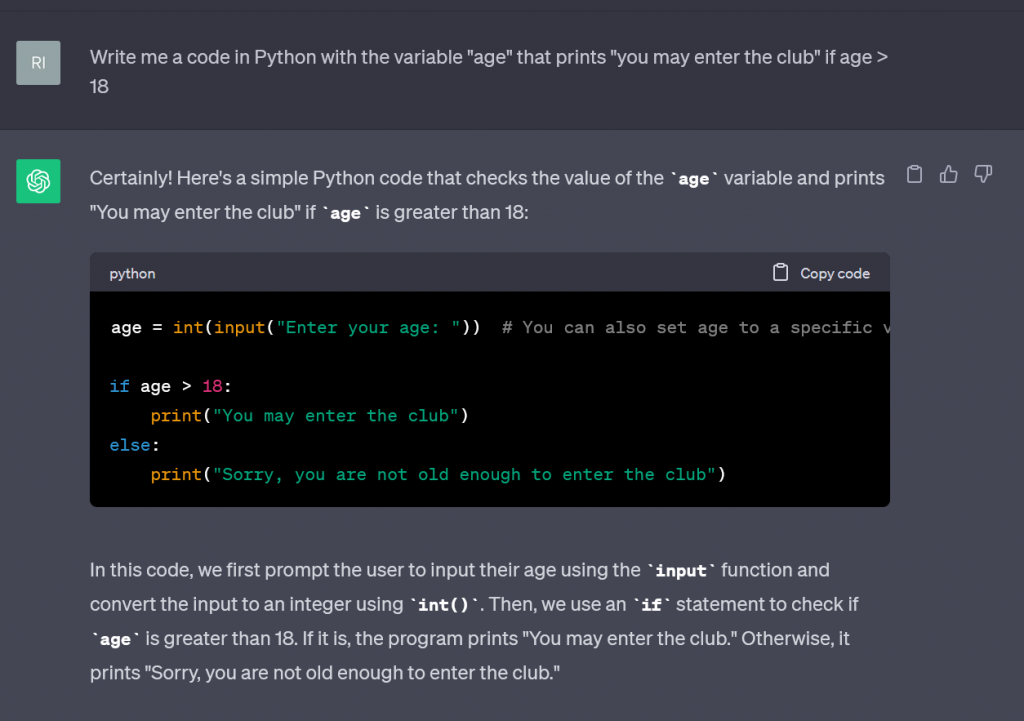Innovative solutions are tearing down learning barriers

Coding and Data Science are careers that are currently in very high demand. Traditionally, getting into coding has involved acquiring a lot of hard skills that take time and dedication. Thanks to ChatGPT, that is no longer true, at least not to the same extent.
ChatGPT’s applications are endless, and writing code is not beyond its capacities. With basic knowledge of how to feed prompts, a user can easily take advantage of GPT’s coding skills and obtain results that extend beyond what the users themselves may know about coding. It is also useful for detecting errors in code, as you can feed it a problematic block of code and, with the right prompt, receive accurate troubleshooting assistance. This can be of great help to newbie coders, as it can essentially act as an experienced programmer to whom you can go for help fixing those errors that you just can’t seem to pin down.

In the image above you can see a crude example of what ChatGPT is capable of. With an extremely simple prompt, GPT was capable of producing a simple code doing exactly what was asked, and even wrote an explanation of the different portions of the code in text. The potential of such applications for learning is immense.
Previously, becoming a self-taught programmer without a formal education was a time intensive task. The best way to learn was through trial and error and with lots and lots of browsing for answers to issues on Google and Stack Overflow (a programming forum). Thanks to Generative AI, there is no longer such a pressing need for these tools and it is possible to obtain customized answers to your questions in an instant. This makes the process much easier, and a lot less frustrating.
But don’t just take my word for it. Academics are also very enthusiastic about the capabilities of ChatGPT for programming. According to Biswas (2023), ChatGPT can be used as a tool to assist in task such as:
- Code Completion and Correction
- Document generation
- Chatbot development
- Text-to-Code Generation
- Answering technical queries
The applications of GPT for programming are also not limited to the conventional chat box. OpenAI, the developer of ChatGPT, offers free access to the API for Python, which can be used to produce prompts for GPT in that programming language, which makes interaction with the AI much more simple while unlocking the potential of more complex prompts, for more complex applications such as building chat bots or creating code. It can sound scary, but this tool is also quite accessible to newbie programmers. OpenAI, in collaboration with DeepLearningAI, released a free crash course titled “ChatGPT Prompt Engineering for Developers” which only requires an introductory level of Python to understand.
When making use of this tool, a programmer can step up the effectiveness of their communication with GPT by an order of magnitude. By utilizing the AI and using programmed prompts, a programmer can obtain much more consistent results from their inquiries and save time spent producing different inputs for every inquiry.
In short, the legitimate applications for ChatGPT seem truly endless. As people continue to gather experience from GPT (and GPT from people), the limits of its usefulness will continue to be tested, and new applications continue to be added. For now, though, newbie programmers like me can breathe a sigh of relief, as their life has been made much easier.
References
Biswas, S. (2023). Role of CHATGPT in Computer Programming. Mesopotamian Journal of Computer Science, 8–16. https://doi.org/10.58496/mjcsc/2023/002
W3 Schools. (n.d.). ChatGPT-4 Coding. CHATGPT-4 coding. https://www.w3schools.com/gen_ai/chatgpt-4/chatgpt-4_code.php
